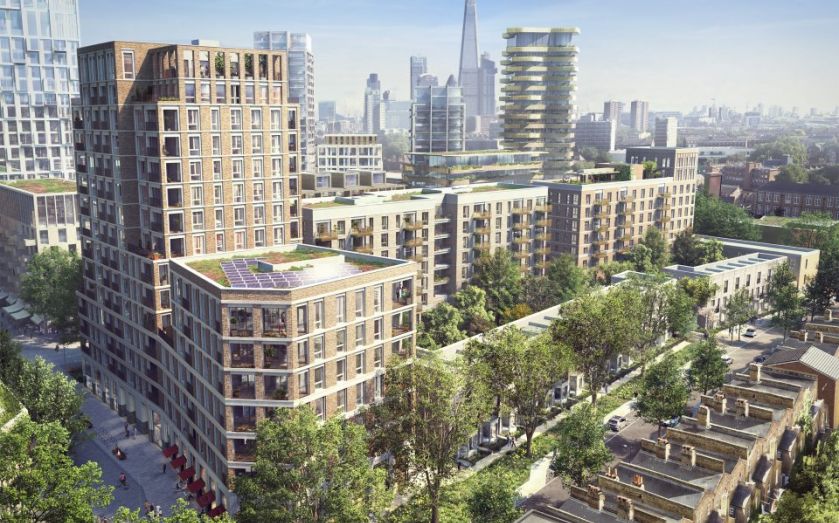| Updated:
Wood you buy a home like this? Meet London’s new timber homes

AN ENGLISHMAN’S home is his castle and his castle is almost always made out of bricks and mortar. Many house buyers take these building materials – along with stone and concrete masonry – for granted but it’s actually something of a national obsession.
In Southern Germany and Austria, the cold mountain climate is perfect for growing thicker, stronger timber at a slow rate. In those countries, it’s used to build around 80 per cent of the buildings of two storeys or less.
Cross-laminated timber (CLT) is structurally engineered boards that are stacked at right angles and glued together over the entire surface in panel layers. The material is more talked about in British construction than ever before as developers look for cheaper, quicker, and more sustainable ways to build houses. Most CLT buildings in Britain have been government-driven so they’re mostly associated with primary schools or libraries. But a new crop of developers are starting to build wooden homes around London.
Richard Cook, head of residential development at Lend Lease, which is redeveloping parts of the Olympic Park in Stratford, Battersea and Elephant & Castle, thinks people will be pleasantly surprised by the results. “I think people hear timber and they think of a Swedish sauna, but it looks just like any other apartment. Timber frames always get a bad press because they’re basically made out of sticks but people don’t realise how solid CLT actually is. It’s a premium product in Europe.” Lend Lease are using CLT in three developments; Cobalt Place, 104 homes split across two buildings in Battersea; Trafalgar Place, 235 homes in Elephant & Castle, part of the £1.5bn regeneration of the Heygate Estate; and Banyan Wharf, 50 apartments in Shoreditch. Not only is it a more durable material than people give it credit for, it also has the potential to save homeowners money on their energy bills. The compact layering of the wood makes it airtight and it has half the air leakage of concrete, reducing the amount of energy needed to heat buildings by almost 40 per cent.

Banyan Wharf in Wenlock Road, Shoreditch
Developers have also become more interested in using CLT to meet sustainability quotas as, unlike concrete, which is a carbon producer, timber is a carbon capturer. It’s the construction equivalent of burning more calories than you consume. “We started looking into it at Lend Lease because we have a holistic approach to building sustainable communities, so that includes thinking about the sort of construction materials we work with,” says Cook. “While we know it saves consumers money on their energy bills and it’s a carbon capturer, it’s hard to give exact figures on developments of a certain size because there hasn’t been enough research into it. Mainly because there aren’t enough developers in the UK using it yet.”
A number of high profile regeneration schemes are looking to change this. Regal Homes is currently planning to build the tallest CLT building in Europe in Hackney. Banyan Wharf, which lies within the Regents Canal Conservation Area, will be 10 storeys high when it’s finished in April 2015, matching the world record currently held by Lend Lease for a block of apartments called Forte in Melbourne, Australia.
Mark Bryan, production director at Regal Homes, says the company chose it for their development because it “fits the eco-lifestyle many people live in Hackney now; cycling to work, drinking green tea… It just seemed appropriate.” Most CLT buildings are planned from start to finish at conception as the material is imported to the UK, in pre-fabricated form, and is assembled on site. This means that early errors in construction can be very costly to the developer as they’d have to transport large loads to the UK again. But perfect the design, and you can reduce the number of deliveries which are, on average, 7.5 time fewer than if you were building with concrete. The erection process produces zero waste and takes far less time to construct. Forte took a team of five labourers just 10 weeks to build.
While Bryan still thinks there’s a long way to go before wooden houses replace bricks and mortar in the hearts of British homebuyers, he thinks London in particular is ready for the change.
“In England, it’s all about heritage,” he explains. “The architecture outside of the cobbles and stone that was around when the Romans invaded has been all bricks and concrete; we’re the world hub of that kind of construction. But London is becoming a lot more continental in its lifestyle and homes no longer need to be just somewhere that’s warm to sleep in, but places that are attractive to work in and socialise in.”